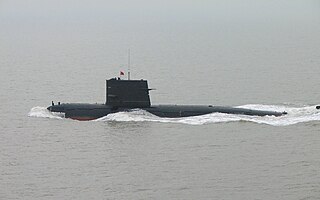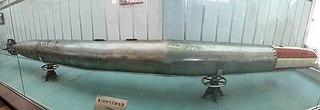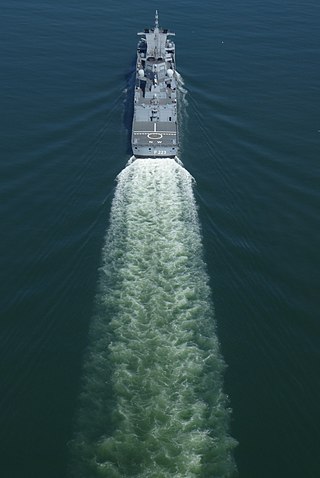
A missile is an airborne ranged weapon capable of self-propelled flight aided usually by a propellant, jet engine or rocket motor.
The Mark 24 Tigerfish was a heavyweight acoustic homing torpedo used by the Royal Navy (RN) during the 1980s and 90s. Conceptual development dates to the mid-1950s, and formally started in 1959 with a target introduction date in 1969. A lengthy development process led to a greatly reduced performance requirement, including the removal of anti-surface capabilities. The first prototype "Tiger Fish" examples were delivered in 1967.
The Spearfish torpedo is the heavy torpedo used by the submarines of the Royal Navy. It can be guided by wire or by autonomous active or passive sonar, and provides both anti-submarine warfare (ASW) and anti-surface warfare (ASuW) capability. Spearfish development began in the 1970s, with production starting in 1988, and deployment in 1992. By 2004, the new weapon had completely replaced the older Tigerfish torpedo.

The Mark 46 torpedo is the backbone of the United States Navy's lightweight anti-submarine warfare torpedo inventory and is the NATO standard. These aerial torpedoes are designed to attack high-performance submarines. In 1989, an improvement program for the Mod 5 to the Mod 5A and Mod 5A(S) increased its shallow-water performance. The Mark 46 was initially developed as Research Torpedo Concept I, one of several weapons recommended for implementation by Project Nobska, a 1956 summer study on submarine warfare.

Type 53 is the common name for a family of 53 cm torpedoes manufactured in Russia, starting with the 53-27 torpedo and continuing to the modern UGST (Fizik-1), which is being replaced by the Futlyar.
The Type 65 is a torpedo manufactured in the Soviet Union and then Russia. It was developed for use against US Navy aircraft carrier battle groups, as well as large merchant targets such as supertankers and advanced enemy submarines. It is now typically fitted to newer Russian vessels, though often the 650 mm torpedo tube is fitted with a 533 mm converter to enable firing of SS-N-15 missiles or Type 53 torpedoes.
Acoustic homing is the process in which a system uses the sound or acoustic signals of a target or destination to guide a moving object. There are two types of acoustic homing: passive acoustic homing and active acoustic homing. Objects using passive acoustic homing rely on detecting acoustic emissions produced by the target. Conversely, objects using active acoustic homing make use of sonar to emit a signal and detect its reflection off the target. The signal detected is then processed by the system to determine the proper response for the object. Acoustic homing is useful for applications where other forms of navigation and tracking can be ineffective. It is commonly used in environments where radio or GPS signals can not be detected, such as underwater.

The PL-7 is the PRC version of the French Magic R.550 air-to-air missile. It is a short-range, Infrared homing missile used by Chinese fighters. It was designed by Wu Shendao, and produced at the Factory 331 (中国株洲航空发动机厂).

The Sting Ray is a British acoustic homing lightweight torpedo (LWT) manufactured by GEC-Marconi, who were later bought out by BAE Systems. It entered service in 1983.

The Mark 37 torpedo is a torpedo with electrical propulsion, developed for the US Navy after World War II. It entered service with the US Navy in the early 1950s, with over 3,300 produced. It was phased out of service with the US Navy during the 1970s, and the stockpiles were sold to foreign navies.

The Type 039 submarine is a class of diesel-electric submarines of the People's Liberation Army Navy. The class is the first diesel-electric submarine to be made in China and also the first Chinese made diesel-electric submarine to use the teardrop hull shape. Altogether thirteen vessels were completed to the Song Class design between 1999 and 2006, with three variants as the type developed.
The People's Liberation Army Navy (PLAN) is the naval branch of the People's Liberation Army (PLA), the armed forces of the People's Republic of China. The PLAN force consists of approximately 250,000 men and over a hundred major combat vessels, organized into three fleets: the North Sea Fleet, the East Sea Fleet, and the South Sea Fleet.

The Yu-1 (鱼-1) torpedo was the first Chinese-built steam-powered torpedo; it was a development of the unguided straight-running Soviet ASuW Type 53 torpedo. It was type classified in September 1971. The Yu-1 was actually the second domestically produced torpedo to enter Chinese service; the first was the Yu-2 torpedo. During the 1980s a version was developed with passive acoustic homing designated the Yu-1A.

Yu-2 torpedo was a Chinese development of the unguided straight-running Soviet ASuW RAT-52 torpedo with passive acoustic homing capability added. The historical background of Yu–2 is identical to that of Yu-1 torpedo and Yu-4 torpedo. Contrary to the higher number assigned, Yu-2 torpedo was the first Chinese domestically produced torpedo entering service, ahead of the Yu-1 torpedo.
The Yu-3 (鱼-3) is a Chinese acoustic homing torpedo designed to be fired from submarines against surface targets. It entered service with the Chinese Navy in 1984. Several sources state that it may be a copy of the Soviet SET-65E, although this seems unlikely as development began in 1965 after the Sino-Soviet split. It is therefore probably the first indigenously developed torpedo in China.
Yu-4 (鱼-4) torpedo is the Chinese development of the Russian SAET-50 ASuW passive acoustic homing torpedo, and it is the Russian SAET-50 torpedo incorporating active acoustic homing guidance. Yu-4 torpedo is often erroneously claimed by many sources as the Chinese version of the SAET-60 acoustic homing torpedo, but Soviets had not completed the development of SAET-60 and only fielded the weapon in 1961, by then the relationship between former-Soviet Union and China had already worsened and China had not received any technical assistance on SAET-60 torpedo. The background of the development of Yu-4 torpedo is identical to that of Yu-1 torpedo and Yu-2 torpedo.
Yu-5 (鱼-5) torpedo is the first wire-guided torpedo developed by China. It is an ASW torpedo designed for conventional diesel-electric submarines. It is often erroneously referred as the Chinese copy of Soviet TEST-71 torpedo, which is incorrect as the Soviet torpedo was developed in 1971 and its successor TEST-71MKE was developed in 1977, at the worst time of Sino-Soviet split. With Yu-5 entering Chinese service in 1989, it was simply impossible to acquire any technologies of Soviet TEST-71 torpedo, which was not purchased by China until 1993, four years after the Yu-5 torpedo had already entered service. The Yu-5 is not a product of indigenous development and is based largely upon previous Soviet and American designs, with much of the propulsion system being derived from the American Mark 46 lightweight torpedo.

The ET52 torpedo is the Chinese development of the Italian Alenia A244-S light ASW acoustic homing torpedo. It is considered by some to be an A244-S torpedo with technologies similar to a US Mk 46 Mod. 2 torpedo.
A nuclear torpedo is a torpedo armed with a nuclear warhead. The idea behind the nuclear warheads in a torpedo was to create a much bigger explosive blast. Later analysis suggested that smaller, more accurate, and faster torpedoes were more efficient and effective.

Wake homing is a torpedo guidance technique based on the wake trajectory left behind a moving target.










